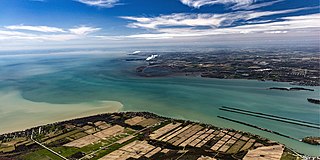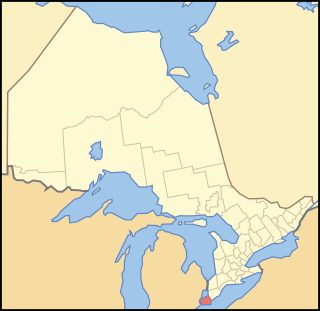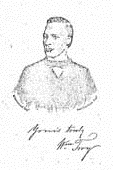
The Detroit River flows west and south for 24 nautical miles from Lake St. Clair to Lake Erie as a strait in the Great Lakes system. The river divides the metropolitan areas of Detroit, Michigan, and Windsor, Ontario—an area collectively referred to as Detroit–Windsor—and forms part of the border between Canada and the United States. The Ambassador Bridge, the Detroit–Windsor Tunnel, and the Michigan Central Railway Tunnel connect the cities.

Essex County is a primarily rural county in Southwestern Ontario, Canada comprising seven municipalities: Amherstburg, Kingsville, Lakeshore, LaSalle, Leamington, Tecumseh and the administrative seat, Essex.

Amherstburg is a town near the mouth of the Detroit River in Essex County, Ontario, Canada. In 1796, Fort Malden was established here, stimulating growth in the settlement. The fort has been designated as a National Historic Site.

The Second Baptist Church, located at 441 Monroe Street within Greektown in Detroit, Michigan, is the oldest African-American church in the Midwestern United States. It was designated a Michigan State Historic Site in 1974 listed on the National Register of Historic Places in 1975.

Lakeshore is a municipality on Lake St. Clair, in Essex County, Ontario, Canada. It was incorporated in 1999 by amalgamating the Town of Belle River with the townships of Maidstone, Rochester, Tilbury North, and Tilbury West. It is the largest and the most populous municipality within Essex County. However, it is part of the Windsor census metropolitan area.

Amherstburg Freedom Museum, previously known as 'the North American Black Historical Museum', is located in Amherstburg, Ontario, Canada. It is a community-based, non-profit museum that tells the story of African-Canadians' history and contributions. Founded in 1975 by local residents, it preserves and presents artifacts of African-Canadians, many of whose ancestors had entered Canada as refugees from United States slavery. They found it relatively easy to enter Canada from across the Detroit River.

Fort Malden, formally known as Fort Amherstburg, is a defence fortification located in Amherstburg, Ontario. It was built in 1795 by Great Britain in order to ensure the security of British North America against any potential threat of American invasion. Throughout its history, it is most known for its military application during the War of 1812 as Sir Isaac Brock and Tecumseh met here to plan the Siege of Detroit. It was the British stronghold during the war and is now a National Historic Site of Canada. The fort also had an important role in securing Upper Canada's border with Detroit during the Upper Canada Rebellion.

Henry Walton Bibb, was an American author and abolitionist who was born into slavery. Bibb told his life story in his Narrative of the Life and Adventures of Henry Bibb, An American Slave, which included many failed escape attempts followed finally by success when he escaped to Detroit. After leaving Detroit to move to Canada with his family, due to issues with the legality of his assistance in the Underground Railroad, he founded the abolitionist newspaper, Voice of the Fugitive. He lived in Canada until his death.
Thornton Blackburn (1812–1890) was a self-emancipated formerly enslaved man whose case established the principle that Canada would not return slaves to their masters in the United States and thus established Canada as a safe terminus for the Underground Railroad.

The John Freeman Walls Historic Site and Underground Railroad Museum is a 20-acre (81,000 m2) historical site located in Puce, now Lakeshore, Ontario, about 40 km east of Windsor. Today, many of the original buildings remain, and in 1985, the site was opened as an Underground Railroad museum. The site forms part of the African-Canadian Heritage Tour in Southern Ontario.
Old Sandwich Town is located along the Canada–US border of the Detroit River, and was established in 1797. It is considered one of the oldest, most historically significant settlements in Ontario and has been the site of several historically significant events in Ontario's history. Many historic buildings remain in Old Sandwich Town and the area hosts an annual festival to celebrate its heritage. The area is now a neighbourhood of the city of Windsor.

The British Methodist Episcopal (BME) Church, Salem Chapel was founded in 1820 by African-American freedom seekers in St. Catharines, Ontario. It is located at 92 Geneva St., in the heart of Old St. Catharines. The church is a valued historical site due to its design, and its important associations with abolitionist activity.

The Reverend William Troy was a Baptist minister and writer associated with the Underground Railroad.
Mary Elizabeth Bibb was an American-born educator and abolitionist leader. She is considered by some to be the first female black journalist in Canada. She was a teacher and abolitionist in the United States, before moving with her husband Henry Bibb to Canada after the passage of the Fugitive Slave Act of 1850 which made it very easy for slavecatchers to capture fugitive and free Blacks. She established schools for Black Canadians, published the Voice of the Fugitive newspaper, and helped African Americans get settled in Canada.
George DeBaptiste was a prominent African-American conductor on the Underground Railroad in southern Indiana and Detroit, Michigan. Born free in Virginia, he moved as a young man to the free state of Indiana. In 1840, he served as valet and then White House steward for US President William Henry Harrison, who was from that state. In the 1830s and 1840s DeBaptiste was an active conductor in Madison, Indiana. Located along the Ohio River across from Kentucky, a slave state, this town was a destination for refugee slaves seeking escape from slavery.

Amherstburg First Baptist Church is a predominantly black church in Amherstburg, Ontario, Canada. It was founded by Anthony Binga Sr. and other Amherstburg residents in 1838. It was constructed in 1848–1849, and became a principal stop on the Underground Railroad. Under the leadership of Reverend Binga Sr. the church was the Mother Church of the Amherstburg Regular Missionary Baptist Association.
The Refugee Home Society was an organization founded in Michigan and Ontario in 1851 that was designed to help former enslaved people become established in a community and remain free. It was located 20 miles from Windsor, Ontario, the border with the United States. The settlement provided purchase of land an easy terms, education, and a community with three churches by 1861.
Isaac J. Rice was a minister and missionary for fugitive slaves from the United States. He operated a mission for arriving black people and a large school for black children at Fort Malden at Amherstburg, Ontario. It was a major landing point for African Americans and the main station of the American Missionary Association.

Black Canadians migrated north in the 18th and 19th centuries from the United States, many of them through the Underground Railroad, into Southwestern Ontario, Toronto, and Owen Sound. Black Canadians fought in the War of 1812 and Rebellions of 1837–1838 for the British. Some returned to the United States during the American Civil War or during the Reconstruction era.















